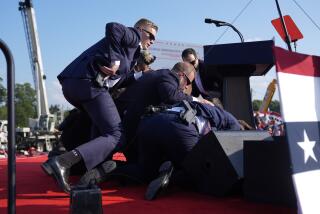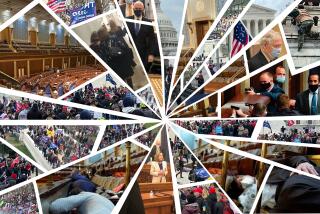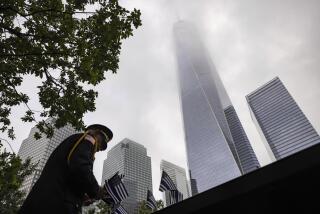Even after Reagan National reopens, D.C. won’t be the same
WASHINGTON — In Washington, the symbol of the free world, nothing will be quite as free and open as it was before September 11.
Ronald Reagan National Airport will reopen Thursday, but it won’t be the same. More than 40 percent of the 792 daily commercial flights that left the airport before Sept. 11 probably will never resume.
There will be some relaxation of the super-tight security measures imposed in the district immediately after the terrorist attacks.
But Washington will remain very much a city of I.D. badge-checking, more cops on street corners, more traffic re-routing, metal detectors tuned to the highest level of sensitivity and new rows of concrete barricades in front of places like the Washington Monument.
Dozens of tiny scenes jolt visitors into realizing they’re at ground zero during one of the most unsettling moments in its history.
At the same time, there is a strong sense that too many restrictions -- too much fear -- will hurt the city and its self-made image as a bastion of democracy.
The challenge: Remain open and free but impose enough security to prevent another attack.
“I believe this attack is going to force the city -- and for that matter, the country -- to figure out how to do that,” said Eleanor Holmes Norton, the District of Columbia’s representative in Congress.
“We’ve never really had to confront the wholesale closedown of parts of cities in order to protect yourself,” said Norton, a Democrat. “It’s going to force the kind of ingenuity that was not at work before.”
While the security noose in Washington is visibly tighter, there are feeble steps being taken to return to normal.
The Pentagon subway station, closed for more than two weeks to anyone except Defense Department workers, is again open to all.
There are fewer D.C. police officers on the streets now than there were in the first post-attack week. And they’ve exchanged their heavy weaponry for standard-issue revolvers. Yet serious concerns remain. White House tours are still suspended, and access to other federal buildings continues to be severely restricted.
A full-scale security audit is under way at the Capitol, where emergency planning was so poor that Senators wandered the front lawn after the Pentagon attack forced an evacuation. Suggestions made in the wake of the 1998 shooting deaths of two Capitol Police officers are being fast-tracked.
“We’re always trying to balance the public’s right of access with legitimate security requirements to protect the Congressional community and our visitors from acts of violence,” said Lt. Dan Nichols, a spokesman for the Capitol Police.
“Our goal remains to keep the complex as open and as inviting as possible,” he said. “But we are taking reasonable and prudent precautions to ensure the safety and security of everyone up here.”
One idea that has gained a new urgency is a $265 million underground visitors center for the Capitol, where tourists could be screened before even entering the building.
Congress already set aside $100 million for the project, and another $68 million has been raised through private donations, said U.S. Rep. John Mica, a longtime champion of the visitors center.
Since the attacks, he said, support has grown considerably for giving more public money to the center to accelerate construction. Congress appears poised to approve roughly $100 million for the project soon.
“There had been a plea for better security, and now with the tragedy of Sept. 11, although the Capitol wasn’t hit, I think it awakened everyone to the need,” said Mica, R-Fla.
The center, which also would protect tourists from the elements and feature educational exhibits about the Capitol, is clearly preferred by public officials to permanently restricting access.
Norton said it’s important to the public psyche that things be left as open as possible. For example, she’s fighting to reopen several side streets near the Capitol that have closed to most traffic and guarded by police since the attacks.
Once a street is closed, she said, it’s very hard to win a fight to reopen it. That’s what happened with the stretch of Pennsylvania Avenue in front of the White House, which was “temporarily” closed to traffic in 1995 after the Oklahoma City bombing and has been at the center of a tug-of-war ever since.
“Neither the House nor the Senate wants to have the Pennsylvania Avenue model thrust upon them, to make the Congress look like it’s going into its bunkers,” Norton said. “That would send a powerful message to the American people: “Stay away from your malls, stay away from your public places, because we won’t even let you into ours.’
“So I don’t think it’s going to happen here.”
President Bush’s plan to open Reagan National Airport is a perfect example of the new, cautious approach to return to some semblance of normalcy.
Shuttle flights to New York and Boston will begin Thursday, followed by service to six other hub cities--Atlanta, Pittsburgh, Chicago, Dallas, Minneapolis and Newark--as soon as new security measures are in place.
After three weeks or so, flights to another 10 cities will be added.
Bush hailed the reopening of the airport as an important economic and psychological step. Reagan National is the only airport in the country that has not returned to service, and thousands of jobs were threatened by the prolonged shutdown.
“There is no greater symbol that America is back in business than the reopening of this airport,” Bush said Tuesday.
But even as the shuttered airport spreads its wings again, it will be a markedly different place.
The dramatic cutback in flights is just one example.
Flight paths also will be severely restricted to avoid sending planes close to secure airspace over the White House and Capitol.
And security at Reagan National will be the tightest in the country, including federal air marshals on most, if not every, plane and flight crews that only go in and out of Washington.
That’s life here in the post-Sept. 11 era--a change that Marine Capt. David Singley noticed right away.
Singley, up from North Carolina’s Camp Lejeune for a conference, missed a chance to tour the Capitol because he arrived too late.
As he sat on an empty sweep of steps, looking out at a Capitol Police officer circling the plaza on a motorcycle, he marveled at how many changes had been made in Washington since his last visit a few years ago.
But then again, he reasoned, a lot has changed since Sept. 11.
“It was a lot more open then. But the situation being what it is, I can’t say I blame them one bit,” he said.
More to Read
Sign up for Essential California
The most important California stories and recommendations in your inbox every morning.
You may occasionally receive promotional content from the Los Angeles Times.










